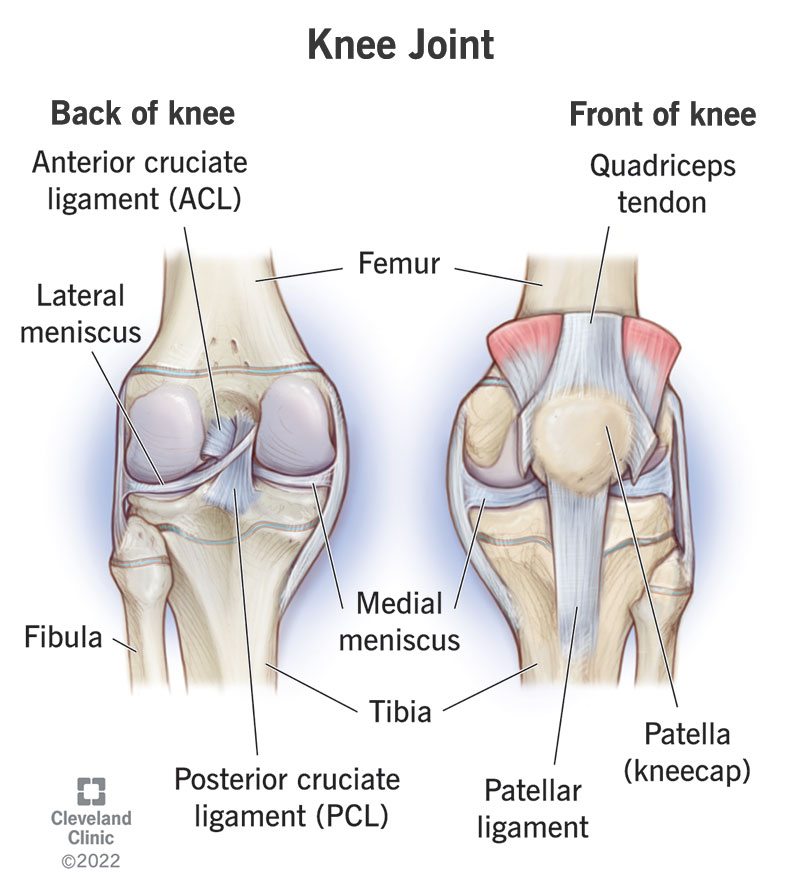The knee joint is the biggest joint in your body. It connects your thigh bone (femur) to your shin bone (tibia). It helps you stand, move and keep your balance. Your knees also contain cartilage, like your meniscus, and ligaments, including your LCL, MCL, ACL and PCL.
Advertisement
Cleveland Clinic is a non-profit academic medical center. Advertising on our site helps support our mission. We do not endorse non-Cleveland Clinic products or services. Policy

The knee is the joint that connects your thigh to your lower leg. It’s the biggest joint in your body.
Advertisement
Cleveland Clinic is a non-profit academic medical center. Advertising on our site helps support our mission. We do not endorse non-Cleveland Clinic products or services. Policy
Like all joints, your knees are part of your skeletal system. Your knees also contain cartilage, muscles, ligaments and nerves.
Your knees help support your weight and let your legs bend and move. Almost any movement that uses your legs relies on your knees — your knees help when you’re walking, running and jumping.
Visit a healthcare provider if you’re experiencing knee pain. They’ll diagnose what’s causing your pain and other symptoms and will suggest treatments that will help you get back to your usual routine and activities.
Your knees have several important jobs, including:
The knee is the joint in the middle of your leg. It’s where your thigh bone (femur) meets your shin bone (tibia).
There are lots of joints and many ways healthcare providers group them together. Joints are usually classified based on:
The knee is a synovial joint. Synovial joints have the most freedom to move. They’re made of a cavity in one bone that another bone fits into. Slippery hyaline cartilage covers the ends of bones that make up a synovial joint. A synovial membrane — a fluid-filled sac that lubricates and protects the joint — lines the space between the bones. This extra cushioning helps synovial joints move with as little friction as possible.
Advertisement
Functionally, the knee is a hinge joint. Think about the hinges that hold a door in place. They have a few parts that don’t move, but other pieces move a specific distance to open and close. Hinge joints like your knee follow the same basic rule — they open and close in one direction.
Your knee is made of:
Three bones make up the knee joint:
The places these bones meet are called articulations or articulating surfaces. There are two articulations in your knee:
Cartilage is a strong, flexible connective tissue that protects your joints. It acts as a shock absorber throughout your body.
There are two types of cartilage in your knee:
Knee ligaments are bands of tissue that connect your thigh bone to your lower leg bones.
There are two types of ligaments in your knee:
Muscles are soft tissue made of stretchy fibers. They tense up (flex) to pull and move parts of your body. Lots of muscles attached to your legs control your knee movements.
Muscles called flexors pull your knee in, including the:
Advertisement
Extensors are muscles that work opposite your flexors — they let you extend your knee out. The extensors that control your knee include the:
Nerves are like cables that carry electrical impulses between your brain and the rest of your body. These impulses help you feel sensations and move your muscles. Nerves in your knee include your:
Your knees can be affected by anything that damages your bones or connective tissue, including:
Sports injuries are some of the most common knee injuries:
The condition or issue that’s affecting your knee will determine which symptoms you experience. Many knee issues cause symptoms like:
Visit a healthcare provider as soon as you notice changes or pain in your knees. Some of the most common tests providers use to diagnose issues include:
Advertisement
A provider might use physical movements and motions to help them diagnose a torn meniscus or ligament damage in your knee, including:
The best way to take care of your knees is to maintain good overall health, including:
Your knees are your biggest joint, and they have a big job — helping you stand, move and use your legs. No matter what you’re doing, you use your knees a lot throughout your daily routine.
Because we use them for so many activities, knees are one of the most injured joints. Everyone has the occasional ache or pain, but don’t ignore symptoms in your knees. Visit a provider as soon as you notice any changes. They’ll help you understand what’s going on inside your knee joint and will find treatments that keep your knees healthy, strong and working like they should.
Advertisement
Cleveland Clinic’s primary care providers offer lifelong medical care. From sinus infections and high blood pressure to preventive screening, we’re here for you.

Last reviewed on 03/02/2023.
Learn more about the Health Library and our editorial process.